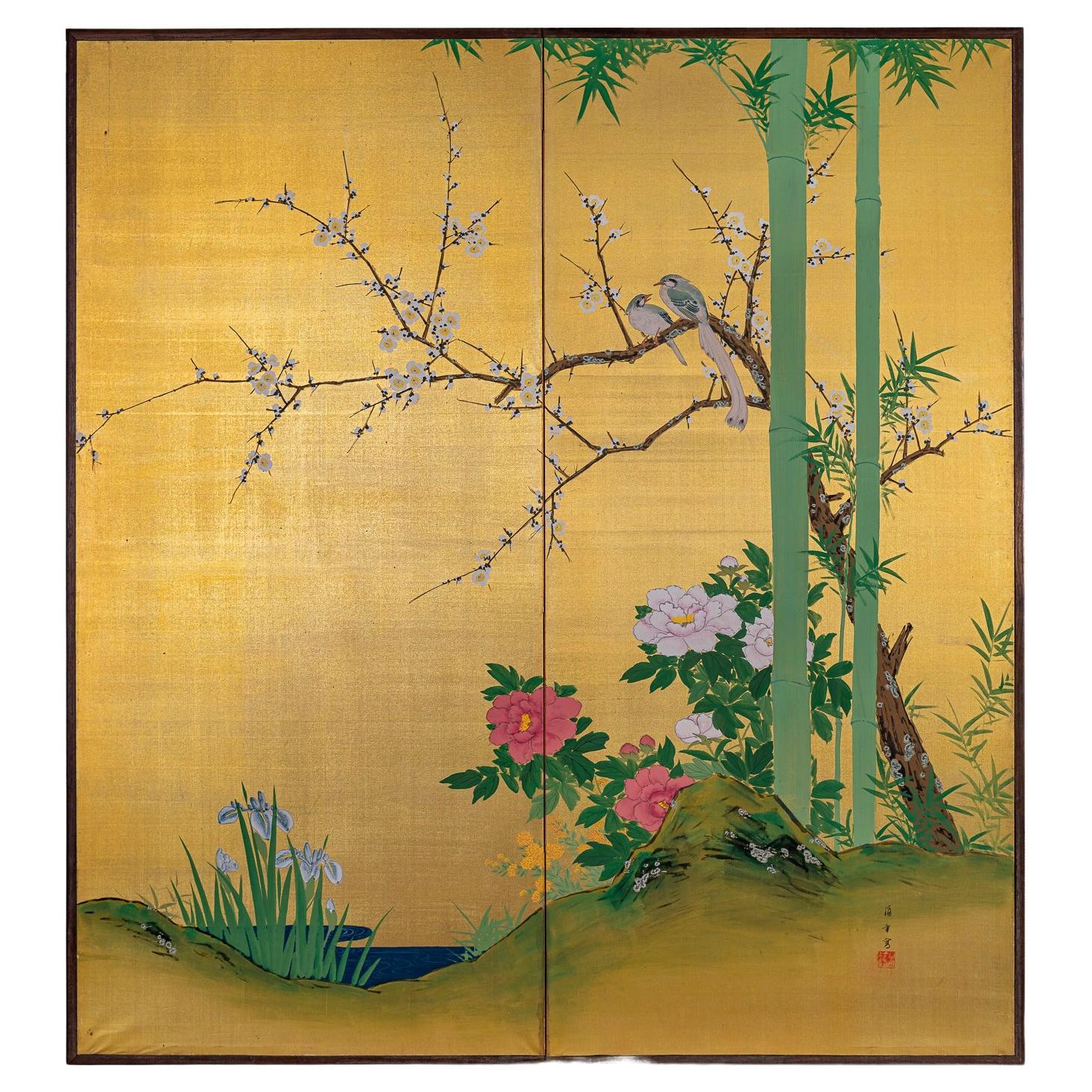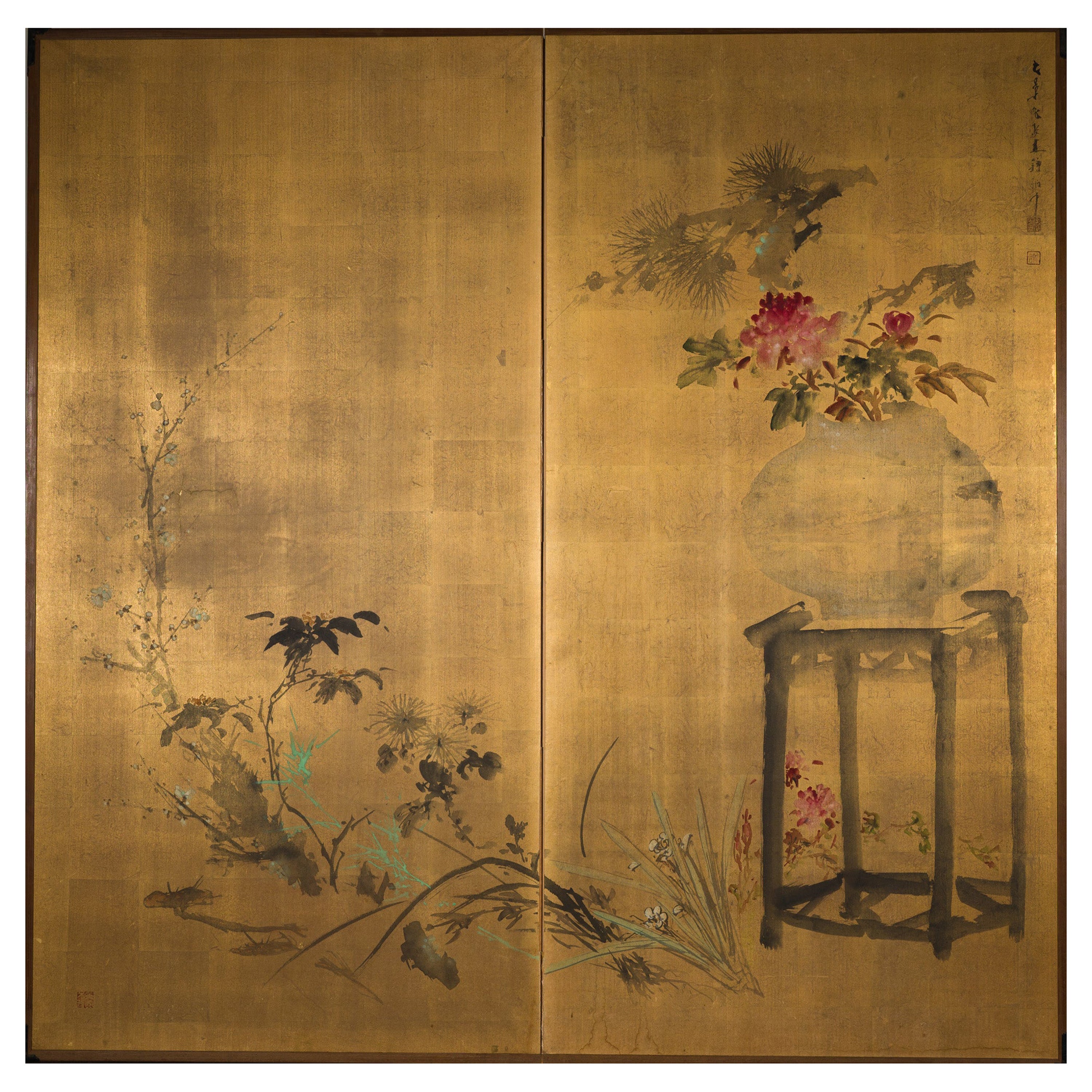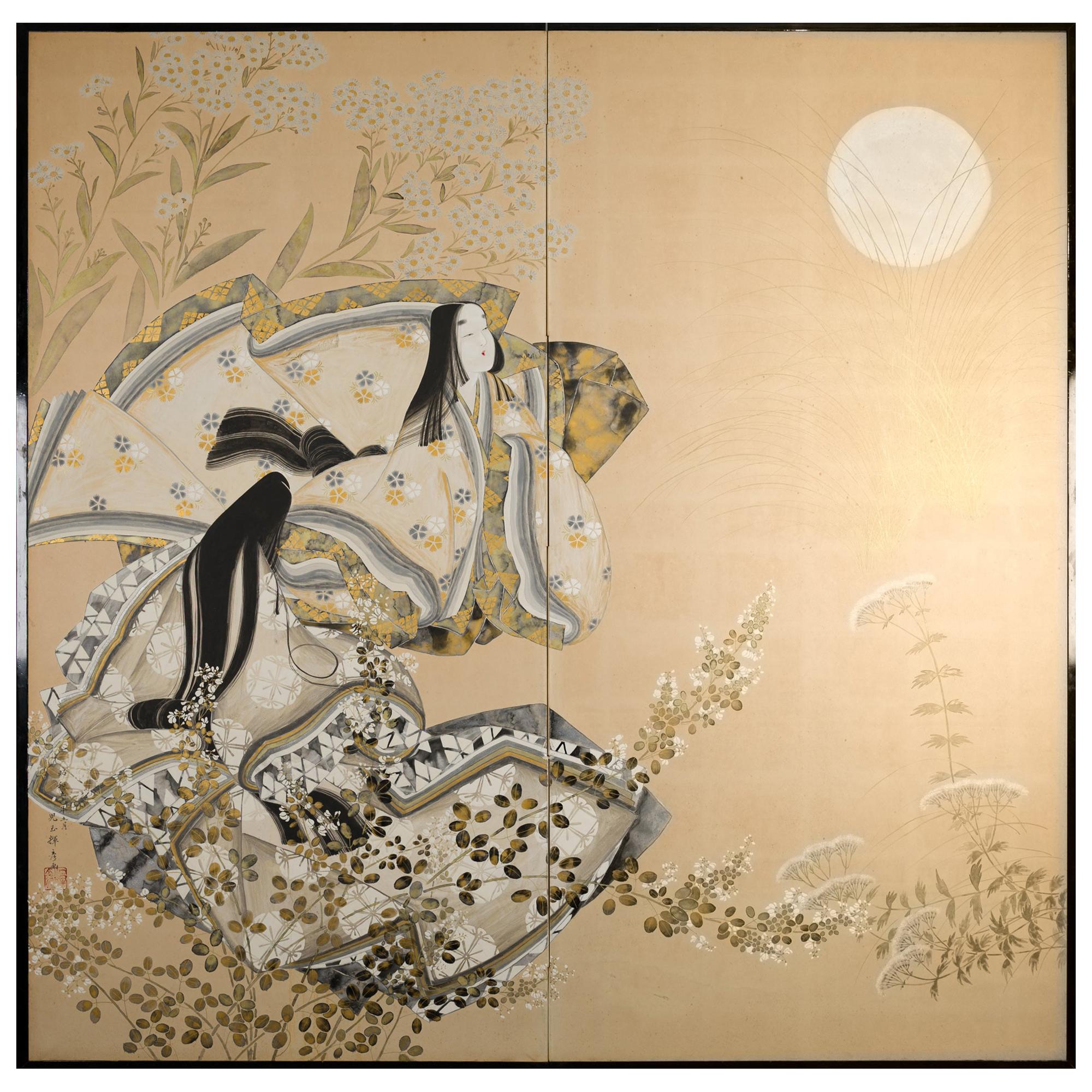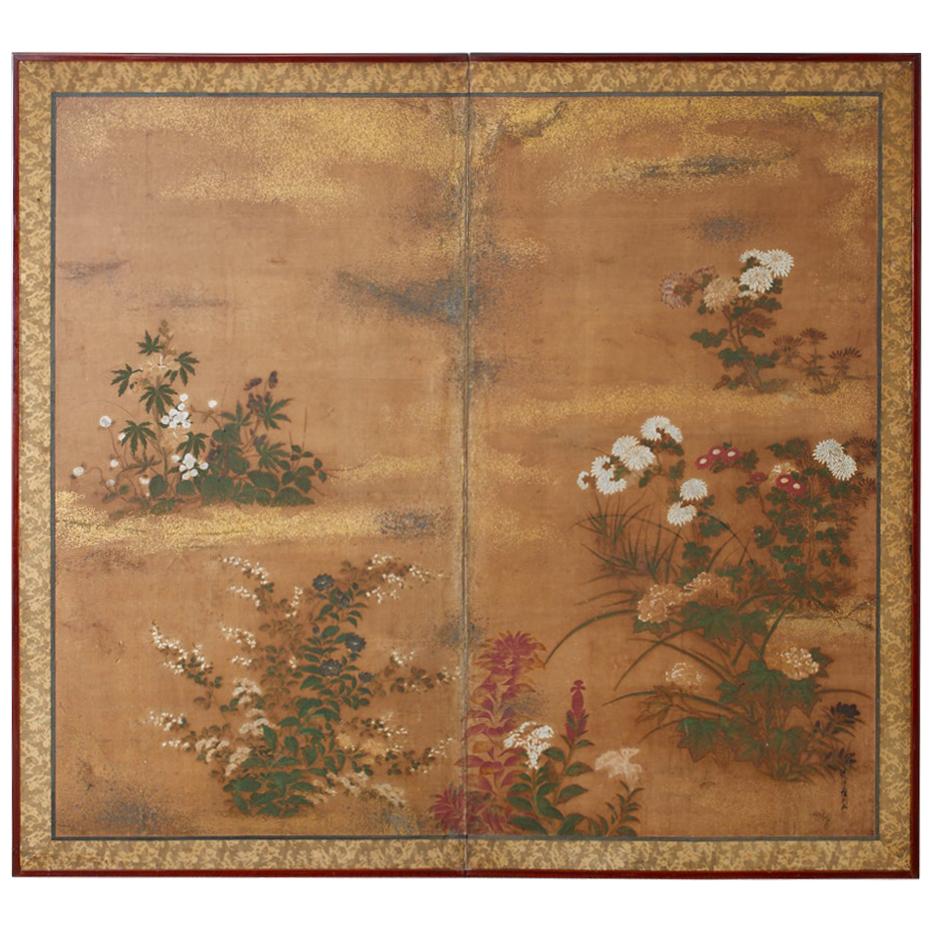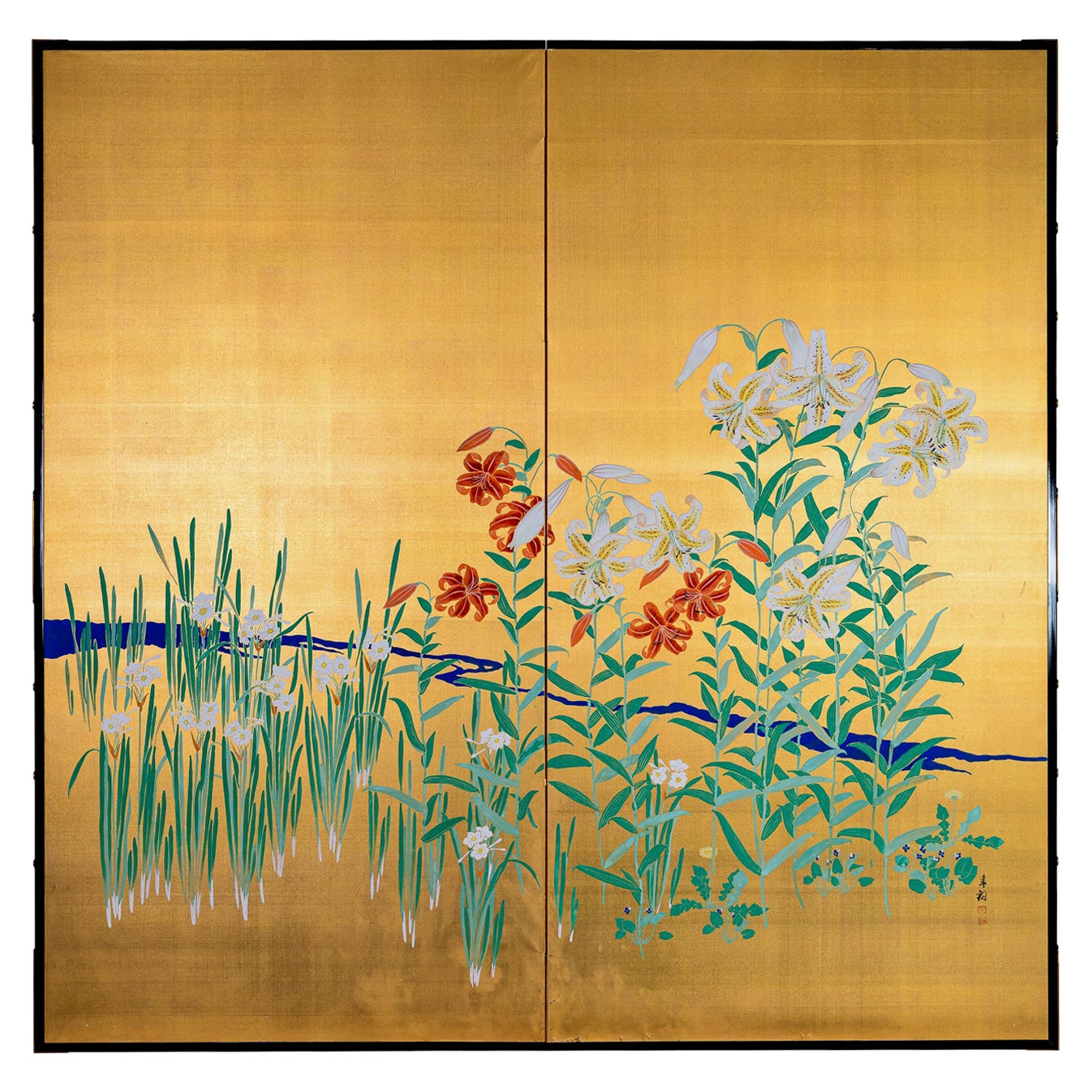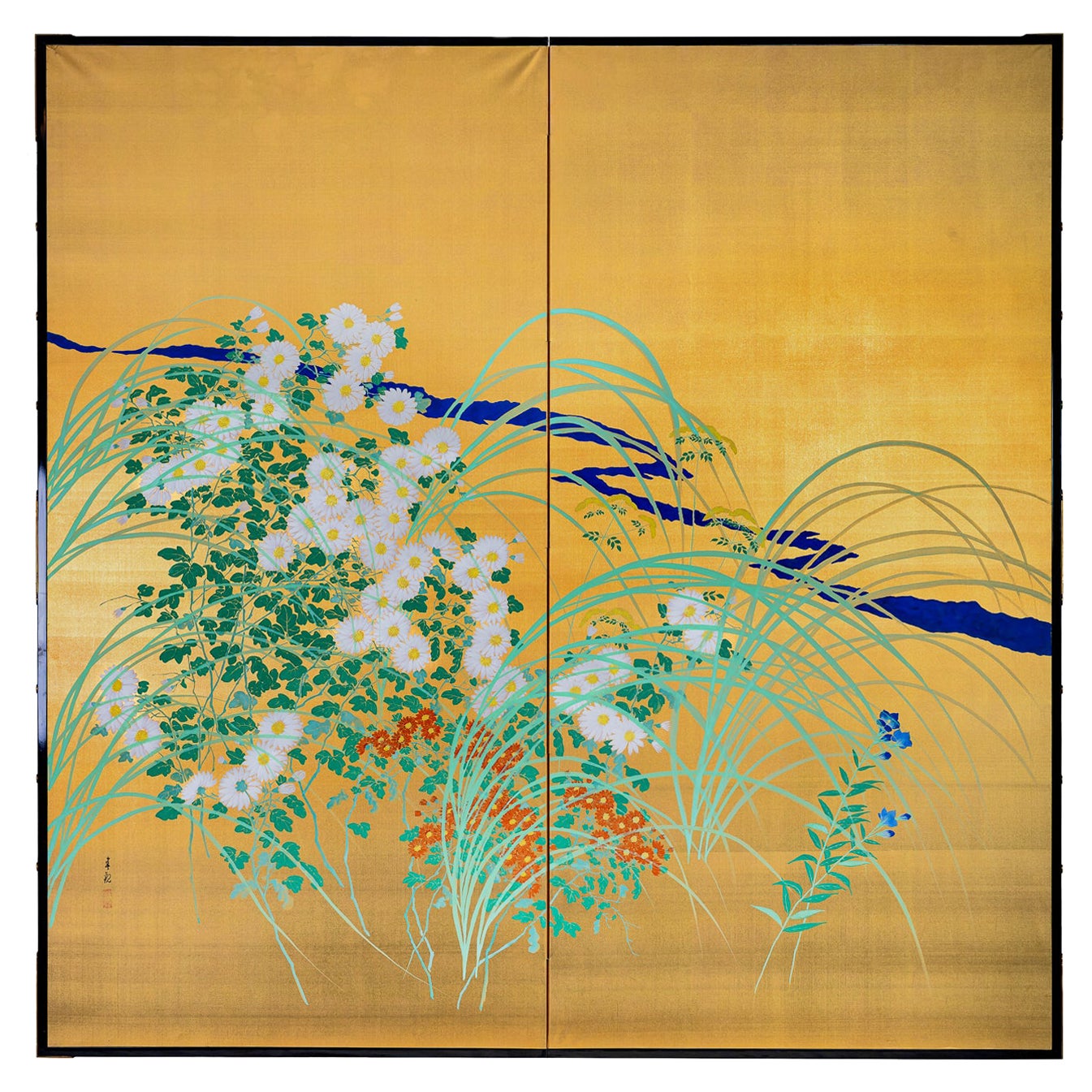Items Similar to Japanese Two-Panel Screen Spring Flowers
Want more images or videos?
Request additional images or videos from the seller
1 of 12
Japanese Two-Panel Screen Spring Flowers
About the Item
A vibrant celebration of spring using a colorful ensemble of coxcomb, irises, lilies, hybiscus, and a blossoming cherry tree. Great examples of "tarashikomi" or "painting-in", a Rimpa painting technique of wet on wet painting to produce pigment "blooms" of color. Mineral pigments on mulberry paper with a silk brocade border. Signed: Oshu saku
- Dimensions:Height: 60 in (152.4 cm)Width: 56 in (142.24 cm)Depth: 0.75 in (1.91 cm)
- Style:Showa (Of the Period)
- Materials and Techniques:
- Place of Origin:
- Period:
- Date of Manufacture:circa 1930
- Condition:Details on request.
- Seller Location:Hudson, NY
- Reference Number:
About the Seller
5.0
Recognized Seller
These prestigious sellers are industry leaders and represent the highest echelon for item quality and design.
Established in 1971
1stDibs seller since 2008
150 sales on 1stDibs
Typical response time: 6 hours
Associations
The Art and Antique Dealers League of AmericaAntiques Associations Members
- ShippingRetrieving quote...Ships From: Hudson, NY
- Return PolicyThis item cannot be returned.
More From This SellerView All
- Japanese Two Panel Screen: Summer FlowersLocated in Hudson, NYScreen depicts Summer flowers and birds on gilded silk. Signature reads: Konishi Fukunen. Notes about Artist: Konishi Fukunen (1887-1959) was born the second son of the Paper mounting specialist Konishi Uhei in Takeo, Fukui prefecture in the mid Meiji period. In 1902 he was sent to Kyoto to study painting under Suzuki Shonen...Category
Mid-20th Century Japanese Paintings and Screens
MaterialsSilk
- Japanese Two Panel Screen: Ikebana 'Flower Arrangement'Located in Hudson, NYMineral pigment on gold silk. Signature reads: Nana Keicho Ho, Shinsho, Gachu ; Seal reads: Soju ; Seal on reverse reads: Koto Fusai.Category
Antique Late 19th Century Japanese Paintings and Screens
MaterialsSilk
- Japanese Two Panel Screen Moon ViewingLocated in Hudson, NYJapanese two panel screen: Moon Viewing, painting of two noblewomen admiring the full moon outdoors. Extremely sophisticated execution of painting ove...Category
Vintage 1970s Japanese Showa Paintings and Screens
MaterialsSilk, Wood, Paper
- Japanese Two Panel Screen: Flowers by River's EdgeLocated in Hudson, NYMineral pigments on gilded silk with gilded bronze hardware. Signature reads: Shunkan.Category
Vintage 1930s Japanese Paintings and Screens
MaterialsBronze
- Japanese Two Panel Screen: Flowers by River's EdgeLocated in Hudson, NYMineral pigments on gilded silk with gilded bronze hardware. Signature reads: Shunkan.Category
Vintage 1930s Japanese Paintings and Screens
MaterialsBronze
- Japanese Two Panel Screen Summer Flowers on SilverLocated in Hudson, NYJapanese two panel screen: Summer flowers on silver. Meiji period painting (1868 - 1912) of Summer flowers including morning glories and daisies against a garden fence. Signature and...Category
Antique Early 1900s Japanese Meiji Paintings and Screens
MaterialsSilver Leaf
You May Also Like
- Japanese Edo Two-Panel Screen Flowers of AutumnLocated in Rio Vista, CAImpressive early 19th century Japanese Edo period two-panel screen featuring flowering plants and grasses of autumn. Painted in the Tosa School style Bunka Bunsei period or Ogosho pe...Category
Antique 19th Century Japanese Edo Paintings and Screens
MaterialsSilk, Wood, Paper
- Japanese Showa Two Panel Screen Blossoming Prunus TreeLocated in Rio Vista, CASerene Japanese Showa period two-panel folding byobu screen depicting a large spring blossoming prunus tree or plum tree. Beautifully painted with ink and natural color pigments on m...Category
20th Century Japanese Showa Paintings and Screens
MaterialsBrass
- Japanese Style Two-Panel Screen Winter Goose in FlightLocated in Rio Vista, CADramatic Showa period two panel folding byobu screen depicting a large white goose in flight in an evening snow covered winter landscape. Made in the American school style watercolor...Category
20th Century Showa Paintings and Screens
MaterialsBrass
- Six-Panel Japanese Screen on Spring Gold LeafLocated in Brescia, ITSpring landscape by an unknown painter of the Rinpa school, 19th century, six-panel ink painted on gold leaf on rice paper. The flowers are made with the "gofun" technique, natural or pigmented white oyster powder. Rinpa (? ?, Rinpa) is one of the major historical schools of Japanese painting. the style was consolidated by the brothers Ogata Korin (1658–1716) and Ogata Kenzan...Category
Antique Late 19th Century Japanese Edo Paintings and Screens
MaterialsGold Leaf
- 20th Century Showa Period Beautiful Spring Garden Folding Screen Two PanelsLocated in Brescia, ITJapanese screen with two doors painted with mineral pigments on rice paper. Early Showa period.Category
Late 20th Century Japanese Showa Paintings and Screens
MaterialsPaper
- Japanese Meiji Two Panel Screen Geese and ReedsLocated in Rio Vista, CAFantastic Japanese late Meiji period two-panel byobu screen by Hashimoto Koshu. The large screen features two white geese amid brightly colored reeds. The symbolism of geese and reeds was introduced to Japan from China in the 13th century. This was a popular subject for Japanese zen artists of the period. Beautifully crafted with exceptional brush strokes and details. Made with natural pigments in dramatic vivid colors of white, pink, and mint green on a silk background of gilt. Circa 1900 with artist seal on bottom right corner. Koshu studied Western art under...Category
20th Century Japanese Meiji Paintings and Screens
MaterialsSilk, Wood, Paper
Recently Viewed
View AllMore Ways To Browse
Theatrical Screens Or Set Pieces
Two Panels
Two Panel
Two Flowers
Brown Screen
Panels Of Flowers
Screened Panels
Japan Flower
Japanese Flower
Circa Screen
Border Vintage Flower
Paneled Asian Screens
Asian Panel Screens
Asian Screens And Panels
Asian Panel Screen Art
Japanese Panel Art
Asian Panel And Screen Paintings
Japanese Asian Panels
